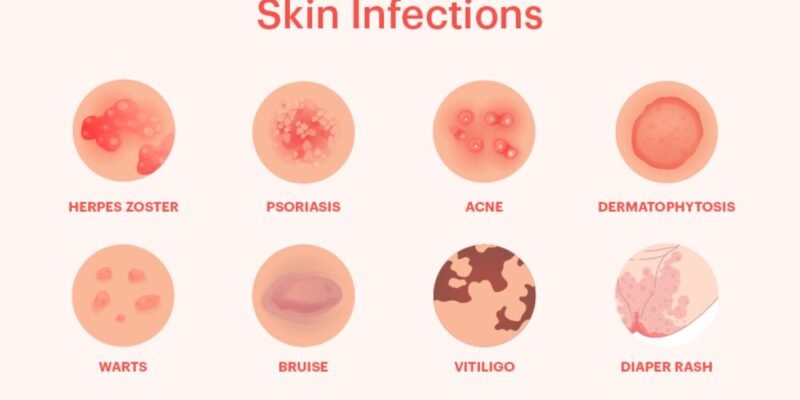Skin infections can occur due to the invasion of the skin by pathogens, for instance, bacteria, viruses, fungi, or parasites. Such infections can vary in severity, and some may require treatment. Here’s a look at some common types of skin infections:
Bacterial Infections
Impetigo
An acute contagious disease of the skin characterized by slight red, vesicular, and pustular eruptions located predominantly on the face around the nose and the mouth. Sight-threatening emergencies are common in children, and antibiotics can manage the condition.
Folliculitis
An infection of hair follicles with the manifestation of red bumps or pustules. Bacteria are most common, although fungus is also a potential cause and is most often treated with topical antibiotics. Refer to the best Skin Specialist in Islamabad for treatment.
Cellulitis
An infection of the deep skin tissues results in rashes, inflammation or redness, and tenderness. It preferentially affects the extremities, particularly the legs or arms, and since Lyme disease is bacterial, it thus has to be treated with antibiotics.
Abscess
It refers to the gathering of pus in a localized area due to bacterial infection. The condition is usually associated with pain and inflammation. Drainage and antibiotics are the standard treatment methods used for treating the condition.
Viral Infections
Herpes Simplex
This is caused by the herpes simplex virus (HSV) and brings about blisters at the edge of the lips or genital area, which are usually painful and are commonly known as cold sores. Prescribed antiviral drugs can be helpful during such incidences.
Shingles
Shingles result from the varicella-zoster virus and are characterized by painful rashes accompanied by blisters, usually occurring on one half of the body. Some antiviral remedies are effective in lowering the severity of the disease.
Warts
HPV-related benign neoplasms can develop on any part of the body and might be temporary or need interventions such as cryotherapy or topical medications.
Fungal Infections
Ringworm (Tinea)
An example of a skin fungal infection is when the skin presents circular red patches that are itchy. It can involve any part of the body and has topical antifungal ointments or oral tablets as medications.
Athlete’s Foot (Tinea Pedis)
A skin disorder caused by fungi that grow on the feet, with symptoms including itching, redness, and skin peeling. The treatment entails the use of antifungal powders or creams.
Candidiasis
An infection caused by the Candida fungus. It can affect some warm and moist areas and manifest symptoms such as itching and discharge. The management of the disease entails the use of antifungal drugs.
Parasitic Infections
Scabies
Tiny bugs cause it, and when it comes into contact with the skin, it results in skin itching and the formation of a rash. The intervention entails the provision of topical drugs to the affected skin in the prescribed dosage.
Lice
Head lice, body lice, and pubic lice make the skin itch and become irritated. Over-the-counter remedies or prescriptions are efficient for the elimination of lice.
Leishmaniasis
An illness caused by parasites in the sandfly, resulting in skin sores. The treatment depends on the kind of infection as well as its degree of progression.
Other Infections
Erysipelas
A skin infection of the epidermis and dermis by bacteria, most commonly Streptococci bacteria. It results in a vivid red, enlarged area at the edge of the flare with apparent weeping that is generally tender.
Necrotizing Fasciitis
A quickly progressing infectious disease of bacterial origin that affects the skin as well as the fatty layer and soft tissues. It becomes a life-threatening situation and deserves aggressive treatment, which ought to be given soon.
Conclusion
Various pathogens characterize skin infections, and therefore, the symptoms of the skin infection may also differ. Common signs are an early indication of leukemia, and getting expert help is essential to avoid worsening symptoms and the disease. Any signs of skin infection should be reported to a skin specialist so that proper assessment and management can be performed.
Do Read: Mental Age Test: Discover Your Cognitive and Emotional Age













